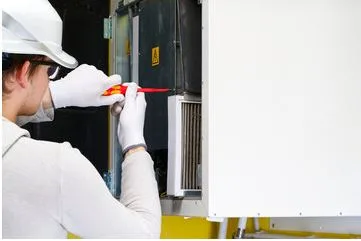What Is Furnace Short Cycling And How Do You Fix It?
Furnace short cycling often occurs when your furnace system turns on and off without reaching the temperature set by the thermostat. For individuals experiencing short cycling, you may realize that your home is not as warm as it should be, making you and your loved ones cold and uncomfortable.
When the temperature in your home falls below the specified temperature on the thermostat, a properly functioning furnace will activate. The furnace will then warm your home until it reaches the temperature set on the thermostat before turning off.
What Exactly Is Furnace Short-Cycling?
Furnace short cycling occurs when a furnace repeatedly turns on and off. It is typical for a furnace to cycle on and off. They are intended to cycle, although a typical house furnace should only turn on and off three to eight times per hour. That implies the average heating cycle ranges from seven to twenty minutes.
If your furnace cycles every few minutes, you know it’s short-cycling. If this is the case, there is most likely a problem. While it is undeniably a problem, short-cycling has one advantage: it reveals that the furnace safety measures are working and preventing a catastrophic disaster, for example, a fire beginning and destroying your home.
Before you analyze the source of a short-cycling furnace, it’s prudent to understand how it operates. Essentially, the blower motor—the fan that distributes the air—sends air via a heat exchanger made up of tubes with burning fuel going through them, and then into the rooms of your house.
Fortunately, there are various signs and safety safeguards in place to prevent the furnace from operating in a harmful manner.
Signs of Furnace Short-Cycling and Preventive Measures
1. Parts issues
More difficult reasons for short cycling could include the furnace blower, flue, or flame sensor.
If the blower motor is turned off, the heat exchangers will not be warming the air and may become overheated, forcing the furnace to shut down. If this is the case, air will not or will only weakly blow through the vents. Place your hand in front of a vent to check. The component that switches off the furnace when the air temperature rises too high may be malfunctioning, causing the furnace to turn off prematurely. You will need to consult an expert to determine this.
Alternatively, the flue could be clogged, which means heated gases aren’t escaping properly, and the furnace’s flue limit switch is forcing the system to shut down before the flue becomes too hot. Typically, the problem is caused by an obstruction in the flue, such as an animal depositing branches in the entrance. Get it checked and cleared out, and your system should be back in action.
Finally, if the furnace’s ignition mechanism malfunctions and fails to produce a flame within four seconds, the sensor will turn the system off. If you suspect this is the issue, have a professional inspect the system; a dirty or damaged flame sensor (thermocouple) or ignitor may be to blame.
2. Contaminated Air Filters
A filthy air filter can cause your furnace to short-cycle. Contaminated air filters prevent airflow and, eventually, produce a backup. This implies that the warm air will remain in the furnace rather than spread throughout your home. Your furnace’s internal temperature will rise, leading the system to shut off. This is when excessive furnace cycling will occur.
To avoid this, replace your air filters at the beginning of each filter cycle, or as directed by your system’s handbook, to prevent blockages. Of course, if you have any questions or concerns about your furnace filter, please contact a skilled HVAC technician.
3. Faulty Thermostats
A malfunctioning thermostat is one possible cause of brief cycling. If your furnace is short-cycling, the first and easiest thing you can do is check your thermostat to verify if it’s functioning properly. A homeowner may forget to switch their thermostat to the heating mode.
As a result, the system shortens the cycle. Before examining furnace components, check that your thermostat is set to “heat” before readjusting. If you want to guarantee that your thermostat is working correctly, consult an HVAC specialist for a more thorough evaluation.
4. Clogged Flue
Any object or pest, such as a bird, can sneak into your flue or vent pipe and produce a clog. In reaction, the furnace will turn off to safeguard you and your family from harmful carbon monoxide. This will result in brief cycling and needs to be treated promptly.
The furnace flue is intended to exhaust dangerous gases. If the chimney is clogged with any object, such as a bird’s nest, dead vermin, or leaves, the furnace will shut down. If not, the furnace will continue to run, causing harmful gases to accumulate inside the house.
To fix this, turn off the furnace and disassemble the flue. Examine each part using a flashlight. Remove any obstacles. Reassemble the flue and start the furnace again.
5. Defective Fan Limit Switch
The fan limit switch indicates when the furnace blower should turn on or off. It is the gatekeeper that regulates the flow of hot air. The fan limit switch is a safety control that will shut down the furnace if it detects overheating.
Fan limit switches are sealed and should not be fixed. This problem can be fixed by replacing the switch. Fan limit switches cost between $100 and $200, excluding labor costs.
How Long Is a Normal Heating Cycle?
To effectively identify whether you have a short cycling problem, you should understand how a typical cycling process works.
With a properly functioning furnace unit, the heating procedure is simple: simply set your thermostat to the desired temperature. The thermostat will activate the furnace, and the burners will be fired using fuel. The fuel then combusts, generating hot air that the blower fan directs through the duct system and distributes around your home.
A standard cycling process takes roughly 15 minutes per cycle if you want to warm up your home slightly. This procedure will continue until the home temperature reaches the desired temperature.
Final Thoughts
If the system has more heating power than is required, it quickly heats your home and turns it off. It turns on again shortly after. Over time, your energy bill will be greater than it should be since the system will use more electricity turning on and off than if it operates continuously. It also causes greater wear and tear on your system, shortening its lifespan. If you feel this is the problem, seek help from a qualified HVAC technician.
Once you’ve identified and resolved the issue, with or without the assistance of a professional, your furnace will be able to function correctly, and you’ll be more comfortable.






